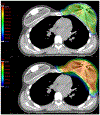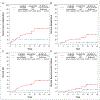Post-mastectomy intensity modulated proton therapy after immediate breast reconstruction: Initial report of reconstruction outcomes and predictors of complications
- PMID: 31185327
- PMCID: PMC7734651
- DOI: 10.1016/j.radonc.2019.05.022
Post-mastectomy intensity modulated proton therapy after immediate breast reconstruction: Initial report of reconstruction outcomes and predictors of complications
Abstract
Purpose: To report reconstructive outcomes of patients treated with post-mastectomy intensity modulated proton therapy (IMPT) following immediate breast reconstruction (IBR).
Materials and methods: Consecutive women with breast cancer who underwent implant-based IBR and post-mastectomy IMPT were included. Clinical characteristics, dosimetry, and acute toxicity were collected prospectively and reconstruction complications retrospectively.
Results: Fifty-one women were treated between 2015 and 2017. Forty-two had bilateral reconstruction with unilateral IMPT. The non-irradiated contralateral breasts served as controls. Conventional fractionation (median 50 Gy/25 fractions) was administered in 37 (73%) and hypofractionation (median 40.5 Gy/15 fractions) in 14 (27%) patients. Median mean heart, ipsilateral lung V20Gy, and CTV-IMN V95% were 0.6 Gy, 13.9%, and 97.4%. Maximal acute dermatitis grade was 1 in 32 (63%), 2 in 17 (33%), and 3 in 2 (4%) patients. Surgical site infection (hazard ratio [HR] 13.19, 95% confidence interval [CI] 1.67-104.03, p = 0.0012), and unplanned surgical intervention (HR 9.86, 95% CI 1.24-78.67, p = 0.0068) were more common in irradiated breasts. Eight of 51 irradiated breasts and 2 of 42 non-irradiated breasts had reconstruction failure (HR 3.59, 95% CI 0.78-16.41, p = 0.084). Among irradiated breasts, hypofractionation was significantly associated with reconstruction failure (HR 4.99, 95% CI 1.24-20.05, p = 0.024), as was older patient age (HR 1.14, 95% CI 1.05-1.24, p = 0.002).
Conclusions: IMPT following IBR spared underlying organs and had low rates of acute toxicity. Reconstruction complications are more common in irradiated breasts, and reconstructive outcomes appear comparable with photon literature. Hypofractionation was associated with higher reconstruction failure rates. Further investigation of optimal dose-fractionation after IBR is needed.
Keywords: Breast cancer; Complications; Post-mastectomy; Protons; Radiotherapy; Reconstruction.
Copyright © 2019 Elsevier B.V. All rights reserved.
Conflict of interest statement
Declaration of Competing Interest
None.
Figures



References
-
- Overgaard M, Nielsen HM, Overgaard J. Is the benefit of postmastectomy irradiation limited to patients with four or more positive nodes, as recommended in international consensus reports? A subgroup analysis of the DBCG 82 b&c randomized trials. Radiother Oncol 2007;82:247–53. - PubMed
-
- Overgaard M, Jensen MB, Overgaard J, Hansen PS, Rose C, Andersson M, et al. Postoperative radiotherapy in high-risk postmenopausal breast-cancer patients given adjuvant tamoxifen: Danish Breast Cancer Cooperative Group DBCG 82c randomised trial. Lancet (London, England) 1999;353:1641–8. - PubMed
-
- Overgaard M, Hansen PS, Overgaard J, Rose C, Andersson M, Bach F, et al. Postoperative radiotherapy in high-risk premenopausal women with breast cancer who receive adjuvant chemotherapy. Danish Breast Cancer Cooperative Group 82b Trial. N Engl J Med 1997;337:949–55. - PubMed
-
- Ragaz J, Olivotto IA, Spinelli JJ, Phillips N, Jackson SM, Wilson KS, et al. Locoregional radiation therapy in patients with high-risk breast cancer receiving adjuvant chemotherapy: 20-year results of the British Columbia randomized trial. J Natl Cancer Inst 2005;97:116–26. - PubMed
-
- Habermann EB, Abbott A, Parsons HM, Virnig BA, Al-Refaie WB, Tuttle TM. Are mastectomy rates really increasing in the United States? J Clin Oncol 2010;28:3437–41. - PubMed
Publication types
MeSH terms
Grants and funding
LinkOut - more resources
Full Text Sources
Medical

